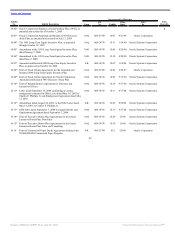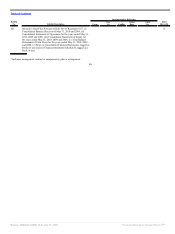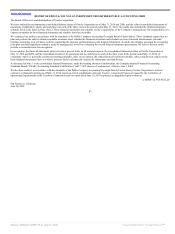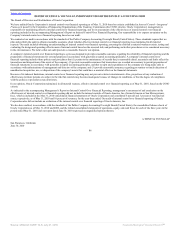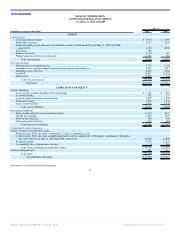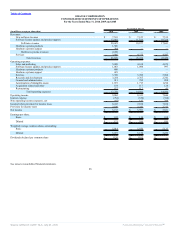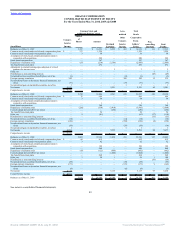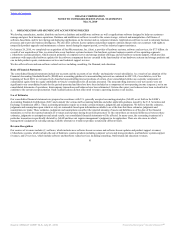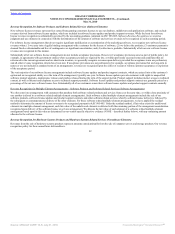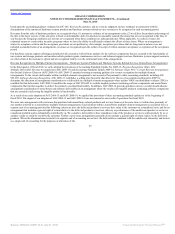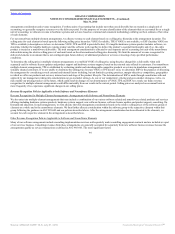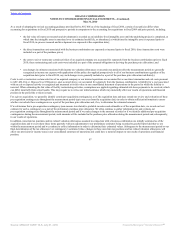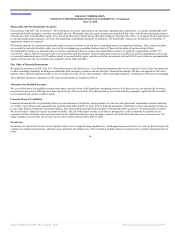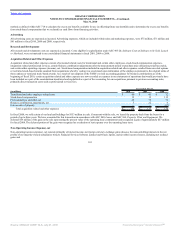Oracle 2009 Annual Report Download - page 95
Download and view the complete annual report
Please find page 95 of the 2009 Oracle annual report below. You can navigate through the pages in the report by either clicking on the pages listed below, or by using the keyword search tool below to find specific information within the annual report.
Table of Contents
ORACLE CORPORATION
NOTES TO CONSOLIDATED FINANCIAL STATEMENTS
May 31, 2010
1. ORGANIZATION AND SIGNIFICANT ACCOUNTING POLICIES
We develop, manufacture, market, distribute and service database and middleware software as well as applications software designed to help our customers
manage and grow their business operations. Database and middleware software is used for the secure storage, retrieval and manipulation of all forms of
software-based data, and for developing and deploying applications on the internet and on corporate intranets. Applications software is used to automate business
processes and to provide business intelligence. We also offer software license updates and product support contracts that provide our customers with rights to
unspecified product upgrades and maintenance releases issued during the support period, as well as technical support assistance.
On January 26, 2010, we completed our acquisition of Sun Microsystems, Inc. (Sun), a provider of hardware systems, software and services, for $7.3 billion. As
a result of our acquisition of Sun, we entered into a new hardware systems business. Our hardware systems business consists of two operating segments:
(1) hardware systems products, which consists primarily of computer server and storage product offerings, and (2) hardware systems support, which provides
customers with unspecified software updates for the software components that are essential to the functionality of our hardware systems and storage products and
can include product repairs, maintenance services and technical support services.
We also offer software and non-software related services including consulting, On Demand, and education.
Basis of Financial Statements
The consolidated financial statements include our accounts and the accounts of our wholly- and majority-owned subsidiaries. As a result of our adoption of the
Financial Accounting Standards Board’s (FASB) new accounting guidance for noncontrolling interests as contained in ASC 810, Consolidation, as of the
beginning of fiscal 2010, we retrospectively classified noncontrolling interest positions of certain of our consolidated entities as a separate component of
consolidated equity from the equity attributable to Oracle’s stockholders for all periods presented. The noncontrolling interests in our net income were not
significant to our consolidated results for the periods presented and therefore have been included as a component of non-operating income (expense), net in our
consolidated statements of operations. Intercompany transactions and balances have been eliminated. Certain other prior year balances have been reclassified to
conform to the current year presentation. Such reclassifications did not affect total revenues, operating income or net income.
Use of Estimates
Our consolidated financial statements are prepared in accordance with U.S. generally accepted accounting principles (GAAP) as set forth in the FASB’s
Accounting Standards Codification (ASC) and consider the various staff accounting bulletins and other applicable guidance issued by the U.S. Securities and
Exchange Commission (SEC). These accounting principles require us to make certain estimates, judgments and assumptions. We believe that the estimates,
judgments and assumptions upon which we rely are reasonable based upon information available to us at the time that these estimates, judgments and
assumptions are made. These estimates, judgments and assumptions can affect the reported amounts of assets and liabilities as of the date of the financial
statements as well as the reported amounts of revenues and expenses during the periods presented. To the extent there are material differences between these
estimates, judgments or assumptions and actual results, our consolidated financial statements will be affected. In many cases, the accounting treatment of a
particular transaction is specifically dictated by GAAP and does not require management’s judgment in its application. There are also areas in which
management’s judgment in selecting among available alternatives would not produce a materially different result.
Revenue Recognition
Our sources of revenues include: (1) software, which includes new software license revenues and software license updates and product support revenues;
(2) hardware systems, which includes the sale of hardware systems products including computer servers and storage products, and hardware systems support
revenues; and (3) services, which include software and hardware related services including consulting, On Demand and education revenues.
91
Source: ORACLE CORP, 10-K, July 01, 2010 Powered by Morningstar® Document Research℠



